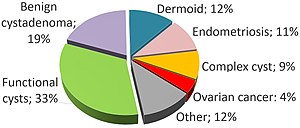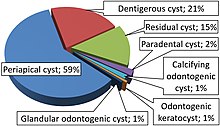Cyst
| Cyst | |
|---|---|
 | |
| H&E stainedmicrographof amediastinalbronchogenic cyst | |
| Specialty | Pathology,general surgery |
Acyst/sɪst/is a closedsac,having a distinct envelope anddivisioncompared with the nearbytissue.Hence, it is a cluster ofcellsthat have grouped together to form a sac (like the manner in which water molecules group together to form a bubble); however, the distinguishing aspect of a cyst is that the cells forming the "shell" of such a sac are distinctly abnormal (in both appearance and behaviour) when compared with all surrounding cells for that given location. A cyst may contain air, fluids, or semi-solid material. A collection ofpusis called anabscess,not a cyst. Once formed, a cyst may resolve on its own. When a cyst fails to resolve, it may need to be removedsurgically,but that would depend upon its type and location.
Cancer-related cysts are formed as a defense mechanism for the body following the development ofmutationsthat lead to an uncontrolledcellular division.Once that mutation has occurred, the affected cells divide incessantly and become cancerous, forming atumor.The body encapsulates those cells to try to prevent them from continuing their division and contain the tumor, which becomes known as a cyst. That said, the cancerous cells still may mutate further and gain the ability to form their ownblood vessels,from which they receive nourishment before being contained. Once that happens, the capsule becomes useless, and the tumor may advance frombenignto cancerous.
Some cysts areneoplastic,and thus are calledcystic tumors.Many types of cysts are not neoplastic, they aredysplasticormetaplastic.Pseudocystsare similar to cysts in that they have a sac filled with fluid, but lack anepitheliallining.
Terminology
[edit]- microcyst – asmall cyst that requires magnification to be seen
- macrocyst –a cyst that is larger than usual or compared to others
Related structures
[edit]Apseudocystis very similar to a cyst, but is a collection of cells without a distinct membrane (epithelialorendothelialcells).
Asyrinxin thespinal cordorbrainstemis sometimes inaccurately referred to as a "cyst".
Cysts by location
[edit]Female reproductive system
[edit]- Nabothian cyst(on the surface of the cervix)[1]
- Ovarian cyst(ovary)[2]
- Paratubal cyst(in front of fallopian tube behind the ovary)[3]

- Vaginal cysts[5]
- Gartner's duct cyst(lateral to vaginal wall)[5]
- Bartholin's cyst(atvaginal introitus)[5]
- Skene's duct cyst(beside theurinary meatus)[5]
- Ectopic ureterocoele (around the urinary meatus)[5]
- Urethral diverticulum (in front of vaginal wall)[5]
Male reproductive system
[edit]- Rete tubular ectasia(within therete testis)[6]
- Epididymal cyst(in theepididymis)
- Hydrocele testis(testicle): clear fluid within thecavum vaginale
- Spermatocele(testicle): fluid within the head of epididymis
Cutaneous and subcutaneous
[edit]- Acnecyst – Pseudocysts associated withcystic acne- an inflammatory nodule with or without an associated epidermoid inclusion cyst
- Arachnoid cyst(between the surface of the brain and thecranialbase or on the arachnoid membrane)
- Epidermoid cyst
- Myxoid cyst(cutaneous condition often characterized by nail plate depression and grooves)
- Pilar cyst(cyst of the scalp)
- Pilonidal cyst(skin infection near tailbone)
- Sebaceous cyst– sac below skin
- Trichilemmal cyst– same as a pilar cyst, a familial cyst of the scalp
Head and neck
[edit]
- Odontogenic cyst
- Ceruminouscyst (ear)
- Chalazion cyst(eyelid)
- Mucous cyst of the oral mucosa
- Nasolabial cyst
- Nasopalatine duct cyst
- Thyroglossal cyst
- Vocal fold cyst
Chest
[edit]- Fibrous cyst(breast cyst)
- Pulmonary cyst(air pocket in the lung)
- Pericardial cyst(abnormal dilatation ofpericardium)
Abdomen
[edit]- Livercysts
- Simple cysts[8]
- Hydatid cysts[8]
- Biliary cystadenoma[8]
- Biliary cystadenocarcinoma[8]
- Polycystic liver disease[8]
- Adrenalcyst (glands located above the kidneys) - It is a rare disease, affecting 0.06 to 0.18% ofautopsystudies. It constitutes 5.4 to 6.0% of adrenal gland diseases. There are five major types of adrenal cysts: simple or endothelial cysts, true or epithelial cysts, pseudocysts, parasitic cysts, and cysts not classified elsewhere. 7% of the cysts can be malignant.[9]
- Renal cyst(kidneys)
- Pancreatic cyst[10]
- Peritoneal inclusion cyst (lining of the abdominal cavity) - It is a cluster of fluid-filled cysts lining the abdominal cavity of reproductive age women with a history of pelvic, abdominal surgeries, or abdominal inflammation. Those affected maybe presented with an abdominal, pelvic, lower back that lasted for months.[11]
- Enteric duplication cyst[12]
Central nervous system
[edit]- Choroid plexus cyst
- Colloid cyst
- Pineal gland cyst(in thepineal glandin the brain)
- Glial cyst
- Tarlov cyst(spinal canal)
Musculoskeletal system
[edit]- Aneurysmal bone cyst,a benign bone tumor with aradiographiccystic appearance.[13]
- Baker's cystor popliteal cyst (behind the knee joint)
- Mucoid cyst(ganglion cysts of the digits)
- Stafne static bone cyst(an anatomic variant with radiographic cystic appearance in theposteriormandible)
- Subchondral cyst (cysts near the bony joints)[14]
Seen in various locations
[edit]- Dermoid cyst(seen in ovaries, testes, and many other locations, from head to tailbone)
- Ganglion cyst(hand and foot joints and tendons)
- Mucoid cyst(ganglion cysts of the digits)
Infectious cysts
[edit]- Cysticercal cyst– an infection due to the larval stage ofTaenia sp.(Crain's backs)
- Hydatid cyst– an infection in the liver or other parts of the body due to the larval stage ofEchinococcus granulosus(tapeworm)
Neoplastic cysts
[edit]Treatment
[edit]Treatment ranges from simpleenucleationof the cyst tocurettagetoresection.There are cysts—e.g.,buccal bifurcation cyst—that resolve on their own, in which just close observation may be employed, unless it isinfectedandsymptomatic.[15]
Cystic fibrosis
[edit]Despite being described in 1938 as "themicroscopicappearance of cysts in the pancreas ",[16]cystic fibrosisis an example of agenetic disorderwhose name is related to fibrosis of thecystic duct(which serves thegallbladder) and does not involve cysts.[17]
This is just one example of how the Greek rootcyst-,which simply means a fluid-filled sac, also is found in medical terms that relate to theurinary bladderand thegallbladder,neither of which involve cysts.
See also
[edit]References
[edit]- ^Okamoto Y, Tanaka YO, Nishida M, Tsunoda H, Yoshikawa H, Itai Y (March 2003). "MR imaging of the uterine cervix: imaging-pathologic correlation".Radiographics.23(2): 425–45, quiz 534-5.doi:10.1148/rg.232025065.PMID12640157.
- ^Farghaly SA (2014)."Current diagnosis and management of ovarian cysts".Clinical and Experimental Obstetrics & Gynecology.41(6): 609–12.doi:10.12891/ceog20322014.PMID25551948.S2CID1512424.
- ^Kiseli M, Caglar GS, Cengiz SD, Karadag D, Yılmaz MB (June 2012). "Clinical diagnosis and complications of paratubal cysts: review of the literature and report of uncommon presentations".Archives of Gynecology and Obstetrics.285(6): 1563–9.doi:10.1007/s00404-012-2304-8.PMID22526447.S2CID5638006.
- ^Abduljabbar HS, Bukhari YA, Al Hachim EG, Alshour GS, Amer AA, Shaikhoon MM, Khojah MI (July 2015)."Review of 244 cases of ovarian cysts".Saudi Medical Journal.36(7): 834–8.doi:10.15537/smj.2015.7.11690.PMC4503903.PMID26108588.
- ^abcdefHeller DS (April 2012). "Vaginal cysts: a pathology review".Journal of Lower Genital Tract Disease.16(2): 140–4.doi:10.1097/LGT.0b013e3182320ef0.PMID22126833.S2CID826917.
- ^Dogra VS, Gottlieb RH, Rubens DJ, Liao L (October 2001). "Benign intratesticular cystic lesions: US features".Radiographics.21 Spec No (suppl_1): S273-81.doi:10.1148/radiographics.21.suppl_1.g01oc15s273.PMID11598263.
- ^Borges LB, Fechine FV, Mota MR, Sousa FB, Alves AP (2012)."Odontogenic lesions of the jaw: a clinical-pathological study of 461 cases".Revista Gaúcha de Odontologia.60(1).
- ^abcdeRawla P, Sunkara T, Muralidharan P, Raj JP (March 2019)."An updated review of cystic hepatic lesions".Clinical and Experimental Hepatology.5(1): 22–29.doi:10.5114/ceh.2019.83153.PMC6431089.PMID30915403.
- ^Pogorzelski R, Toutounchi S, Krajewska E, Fiszer P, Pachucki J, Bednarczuk T, et al. (2015)."Laparoscopic treatment of adrenal cysts--own research and literature review".Endokrynologia Polska.66(5): 469–72.doi:10.5603/EP.2015.0057.PMID26457502.
- ^Stark A, Donahue TR, Reber HA, Hines OJ (May 2016). "Pancreatic Cyst Disease: A Review".JAMA.315(17): 1882–93.doi:10.1001/jama.2016.4690.PMID27139061.
- ^Vallerie AM, Lerner JP, Wright JD, Baxi LV (May 2009). "Peritoneal inclusion cysts: a review".Obstetrical & Gynecological Survey.64(5): 321–34.doi:10.1097/OGX.0b013e31819f93d4.PMID19386139.S2CID34639668.
- ^Liu R, Adler DG (July 2014)."Duplication cysts: Diagnosis, management, and the role of endoscopic ultrasound".Endoscopic Ultrasound.3(3): 152–60.doi:10.4103/2303-9027.138783.PMC4145475.PMID25184121.
- ^Zadik Y, Aktaş A, Drucker S, Nitzan DW (December 2012). "Aneurysmal bone cyst of mandibular condyle: a case report and review of the literature".Journal of Cranio-Maxillo-Facial Surgery.40(8): e243-8.doi:10.1016/j.jcms.2011.10.026.PMID22118925.
- ^Bancroft LW, Peterson JJ, Kransdorf MJ (January 2004). "Cysts, geodes, and erosions".Radiologic Clinics of North America.42(1): 73–87.doi:10.1016/S0033-8389(03)00165-9.PMID15049524.
- ^Zadik Y, Yitschaky O, Neuman T, Nitzan DW (July 2011). "On the self-resolution nature of the buccal bifurcation cyst".Journal of Oral and Maxillofacial Surgery.69(7): e282-4.doi:10.1016/j.joms.2011.02.124.PMID21571416.
- ^Andersen DH(1938). "Cystic fibrosis of the pancreas and its relation to celiac disease".American Journal of Diseases of Children.56(2): 344–399.doi:10.1001/archpedi.1938.01980140114013.
- ^Greenholz SK, Krishnadasan B, Marr C, Cannon R (February 1997). "Biliary obstruction in infants with cystic fibrosis requiring Kasai portoenterostomy".Journal of Pediatric Surgery.32(2): 175–9, discussion 179-80.doi:10.1016/S0022-3468(97)90174-3.PMID9044117.
External links
[edit]- Stöppler, Melissa Conrad."What Is a Cyst? Types, Symptoms, Signs, and Causes".MedicineNet.
- De Maio, Fernando; Di Marcantonio, Arianna; De Luna, Vincenzo; Caterini, Alessandro; Tresoldi, Ilaria; Farsetti, Pasquale (2020)."Synovial cyst of the acromioclavicular joint with and without rotator cuff tear: A case series of two patients".International Journal of Surgery Case Reports.75:390–393.doi:10.1016/j.ijscr.2020.09.084.PMC7522442.PMID32992095.
